Skill only gets you as far as your rifle allows, so why let your rifle hold you back? With a few simple changes, you can easily make your AR15 more accurate. The modularity of the AR-15 is one of its biggest advantages. You can take almost any rifle and upgrade its performance with a little time on the workbench. All you need to do is prioritize which upgrades will benefit you most. Then work step-by-step to build your dream rifle. With that in mind, let’s look at some of the best AR-15 upgrades to help improve your accuracy.
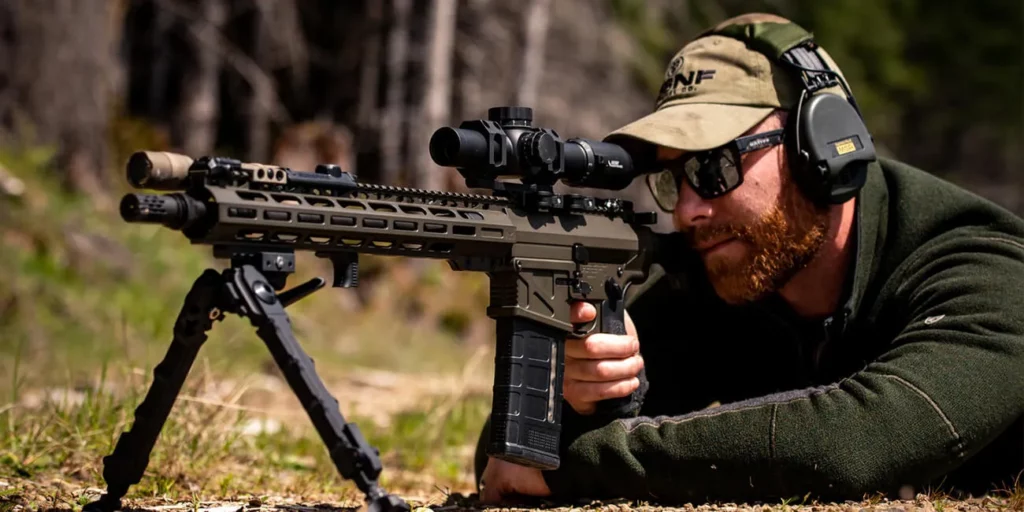
Best AR-15 Upgrades: Optics
The single best AR-15 upgrade is a quality optic. If you can’t aim small, you can’t hit small, and even if your rifle is capable of accurate shots out to 300 yards, your eyes may not be. Thankfully, a quality optic will help you bridge that gap.
There is an extremely wide variety of optics to choose from at a range of price points that suit your budget today. Based on your intended use, you may want a red dot sight, a fixed magnification compact prism scope, or a variable magnification scope. Each option has benefits and drawbacks depending on the purpose of your rifle, so let’s take a look.
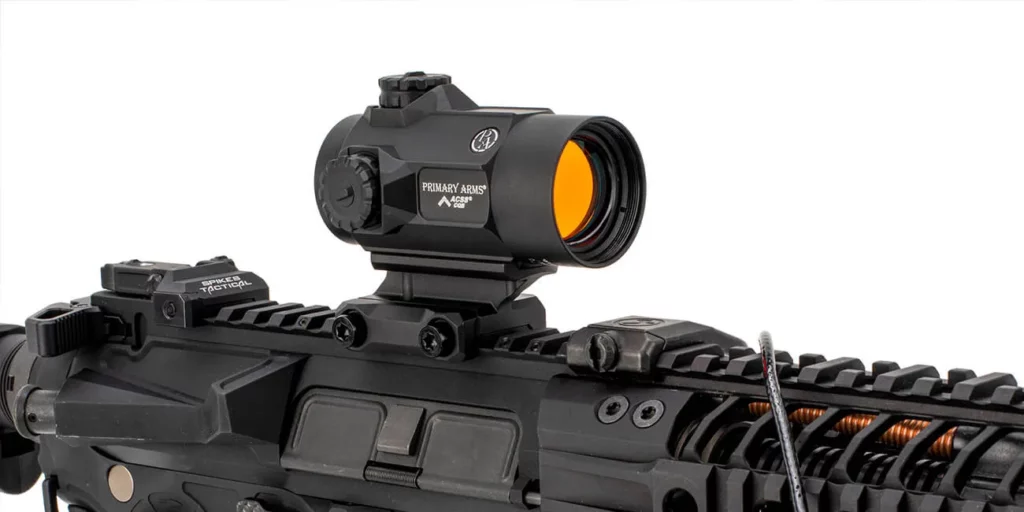
Red Dots
Red dots have soared in popularity for ARs. There’s a good reason for that. Red dots help you get on target quickly. You can keep both eyes open while aiming to maintain full situational awareness. With a conventional scope, you have to position your eye just the right distance from the optic. Not with a red dot. All you have to do is look through the glass. There’s no eye relief or exit pupil to worry about. And red dots are extremely lightweight.
Military and law enforcement have widely adopted red dots. They’re a great option for rifles intended to be used at self-defense ranges from 0 to 100 yards. If your range has all targets under 100 yards—as many do—a red dot might be the perfect choice.
But red dots are not for everyone. Gun-owners with astigmatism may not see a crisp dot, and the lack of magnification can limit your effectiveness beyond 300 yards or so. Fortunately, red dot magnifiers can solve both these problems by providing additional magnification with an adjustable diopter.
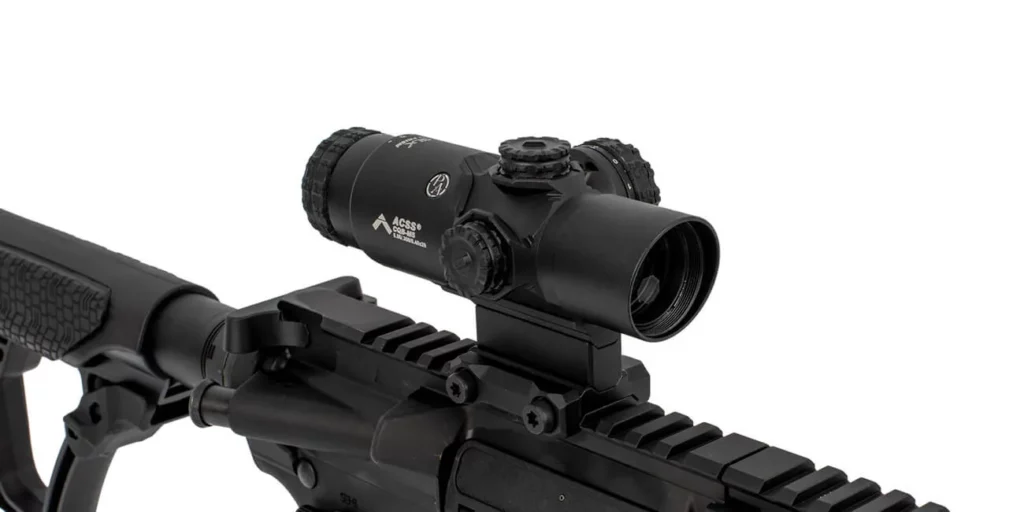
Shop All Red Dots and MagnifiersBuy Now
Prism Scopes
Prism scopes are a staple of the optics world, providing fixed magnification in a smaller footprint than a rifle scope. Most prismatic scopes offer an illuminated reticle, but unlike a red dot, the prism reticle is etched into the glass. That way, if your battery goes out, the reticle will lose illumination but not disappear. The inclusion of an adjustable diopter will also solve the issue of astigmatism, even on compact 1x prism scopes.
For many, the prismatic scope is the perfect balance between size, weight, capabilities, and durability. The fixed magnification of prism scope is typically from 1x to 6x, which is ideal for the AR 15. You can choose from many advanced reticle designs too, including our Primary Arms ACSS® reticles, which are incredibly versatile and take the guesswork out of long-range ballistics.
Since prism scopes only offer fixed magnification, they aren’t as versatile as variable scopes, but their durability and consistency make them a popular option for enthusiasts and professionals alike.
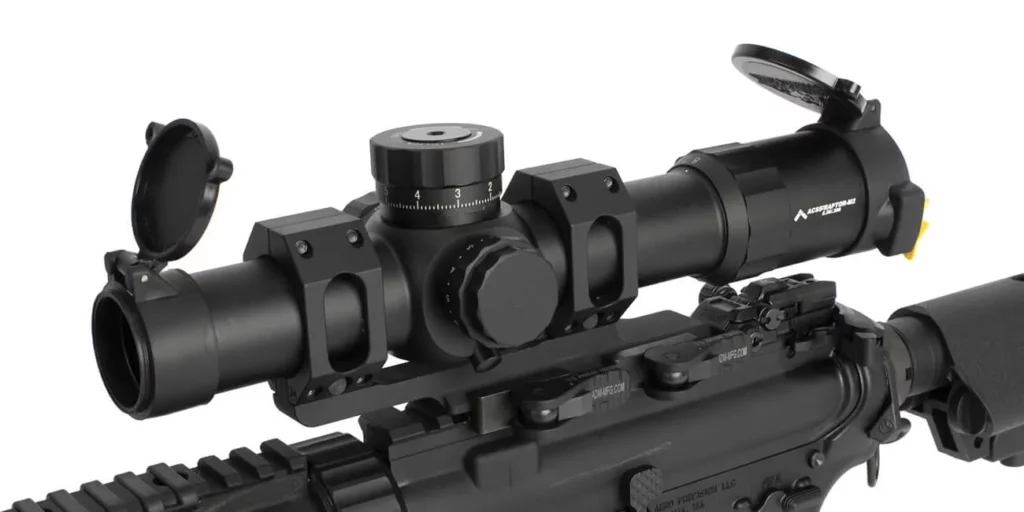
Variable Power Scopes
When it comes to versatility, few optics can compare with a variable rifle scope.
Variable power scopes let you manually adjust the magnification, so you get more flexibility for a variety of circumstances. For AR15s, the most popular variable power scope would be the ‘Low-Power Variable Optic’ (LPVO). This includes scopes with a 1x minimum magnification and a max magnification somewhere between 4x and 10x. All variable power scopes fall into two categories: First Focal Plane (FFP) and Second Focal Plane (SFP).
With an FFP scope, the reticle visually grows and shrinks as you change your magnification setting. This ensures that your zero and bullet drop compensation marks that are etched into the reticle remain accurate at any magnification.
An SFP scope’s reticle remains the same size as the magnification changes, resulting in a consistent sight picture. However, any bullet drop compensation marks will only be accurate at the maximum power setting.
While variable scopes have many benefits, there are a few downsides. Variable scopes are heavier than red dots or prism scopes. They can also be more expensive—especially when you’re adding in the cost of a good mount.
If you’re new to variable power scopes, you might be shocked by how widely prices can vary. From a hundred dollars up to thousands of dollars. The main reason is glass quality. Premium-grade optics come with premium-grade glass, which helps greatly when shooting at long distances. Whatever your budget allows, make sure your scope scores well for glass quality in its reviews.
Best AR-15 Upgrades: Trigger
After optics, the second-best thing you can do to improve your rifle’s practical accuracy is upgrade the trigger. Your standard Mil-Spec trigger might feel a bit mushy or inconsistent. If you’re shooting quickly, it could be easy to mess up the reset and miss a shot.
Fortunately, there is a wide range of aftermarket triggers available. Switching out yours is probably easier than you think. Beyond improving accuracy, a new trigger can just feel good to shoot. With match-grade options starting at around $100, triggers are one of the best AR-15 upgrades for your money, too.
First, let’s go through some key terms so you understand everything you get when shopping for a new trigger.

The pull weight is how much force is required to trip or “break” the sear and send the hammer forward to hit the firing pin and ignite the primer on your cartridge. An average Mil-Spec trigger can have a pull weight of 5.5 pounds or more. Many aftermarket triggers are much lighter than this and make it easier to squeeze off a shot without affecting the point of impact.
The trigger shoe is the part your finger touches. Some AR triggers offer a curved or bowed shoe. Some shooters prefer a straight shoe, which has a unique feel and look. People will argue over this endlessly, but the bottom line is that with enough training, it’s largely a matter of personal preference.
You’ll need to decide if you prefer a single-stage or two-stage trigger. The difference is quite simple. A single-stage requires one solid amount of pressure before the trigger breaks. When you pull a two-stage trigger, the first stage is a loose and easy “take up” before you hit a “wall” of greater resistance. Pulling the trigger through that wall usually requires less pressure than a comparable single-stage.
Shop All AR-15 TriggersBuy Now
Single-stage triggers are common on AR-pattern rifles. They can be great for rapid fire, which makes them popular among competitive shooters. Double-stage triggers allow you to pull right up to the wall and have a little more knowledge about when the trigger is going to break. Some shooters believe this benefits their accuracy. Two-stage triggers are popular among hunters allowing them to stage the trigger and get ready for the shot.
Once you decide on a single-stage or a two-stage trigger, there are a nearly unlimited array of options for the physical construction of the trigger you may want to put on your rifle. Whatever you decide, it’s a good idea to buy from a reputable manufacturer like Geissele, CMC Triggers, Timney Triggers, Rise Armament, or any other brand with a track record of quality.
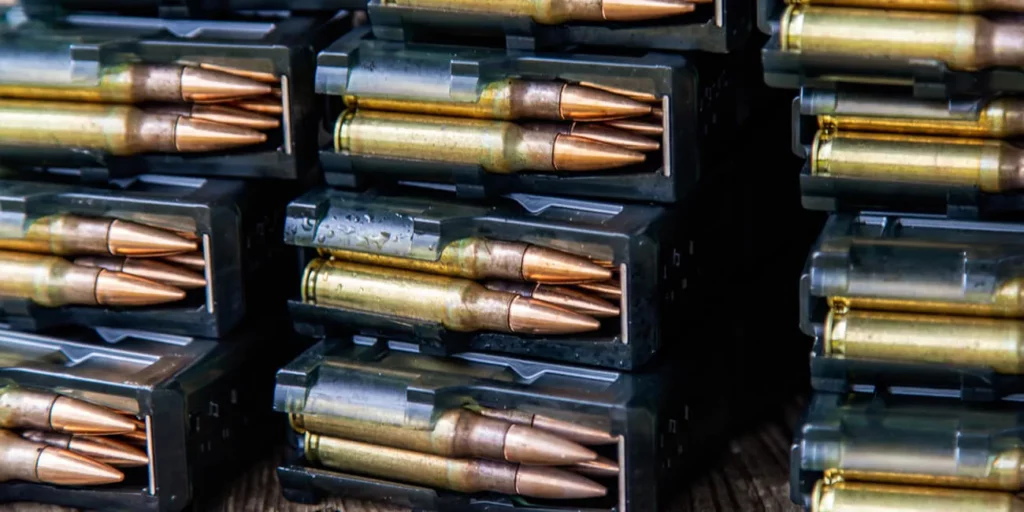
Best AR-15 Upgrades: Ammunition
Ammunition is just as important as the rifle itself.
Cheap ammunition is cheap for a reason. Quality control is not as precise. When you shoot a 5-round group of inexpensive steel-cased ammo, each round may not perform identically to the next. Sometimes, that’s totally fine. Other times, it’s a limiting factor.
But if you spend your entire budget on high-end ammo that costs $2/round, you’re probably not going to shoot as much as you should to improve your skills. That’s why it’s important that your home ammo stockpile includes a mix of different cartridges for different purposes: cheap ammo for plinking and training, more expensive ammunition for self-defense, competition, and hunting.
When it comes to accuracy, precision match-grade ammunition will make a difference. Open tip match (OTM) bullets, for example, are manufactured to be very uniform and retain their shape when fired. This ensures that consistency from round to round will keep your groups tight.
Best AR-15 Upgrades: Free Float Handguards
You’re running through the woods, see your target, and throw yourself onto a barricade to stabilize your rifle. With the target exactly in your crosshairs, you squeeze the trigger. Bang! You miss. Why?
When you are on a barricade and pressing against a non-free-float handguard, you could be shifting the point of impact. Even a sling pulled tight to stabilize the rifle could be enough pressure to pull the barrel off target.
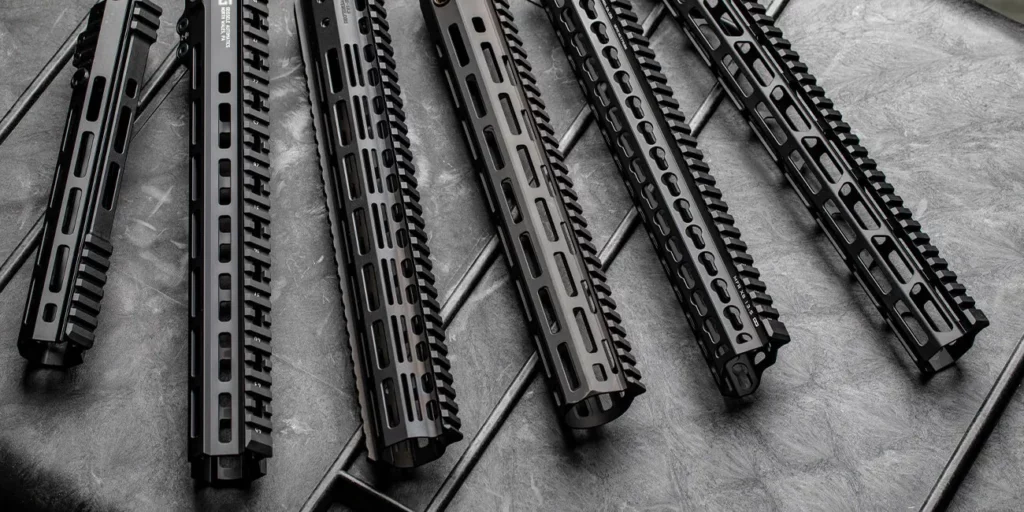
Free-float handguards remove this problem by ensuring your handguard is only attached to the upper receiver. Forward of the upper receiver, the barrel is literally ‘floating’ in the middle of the handguard. This also provides some advantage in retaining ideal barrel harmonics. For many shooters, being able to move your support hand out towards the end of the rifle provides a major improvement in shooting stability.
There are other advantages of a free-floated barrel besides accuracy. You often get extra rail real estate to attach accessories. Your rifle is going to look way cooler, too. This upgrade involves some additional modifications, so you need to make sure you’re prepared. You will need to remove your Delta ring, possibly your barrel nut, and the A2 front sight (in most cases), replacing it with a low-profile gas block.
Research the best methods on how to do the modifications to ensure that your rifle and gas system will function reliably after the upgrade.
Best AR-15 Upgrades: Barrels
Mechanical accuracy begins with the barrel. The old saying, “You can’t build a good gun around a bad barrel,” speaks to the centrality of this core component.
Most ARs will ship with fairly accurate barrels, but that doesn’t mean they can’t be improved.
A barrel replacement can improve accuracy, especially at long range. While they can be expensive to upgrade, a top-quality barrel can have a huge impact on your rifle’s mechanical accuracy, making this one of the best AR-15 upgrades possible for shrinking your groups.
Here are the things to consider when shopping for an AR-15 barrel upgrade.

MATERIAL AND PRODUCTION
A chrome-lined, cold-hammer forged heavy barrel might be great for a duty rifle, but that doesn’t mean it’s what you need for amazing accuracy. Some barrels are designed to be rugged and reliable. Others are intended to maximize precision.
If your main goal is accuracy above all else, a stainless-steel barrel could give you a slight edge. Because stainless steel is softer, it’s easier for manufacturers to make the rifling more precise. For that same reason, a stainless-steel barrel won’t last as long as a chrome-lined or nitrided steel barrel, but it could help you turn your AR into a tack driver.
LENGTH
Barrel length has less to do with accuracy than many people think. A poorly made 24-inch barrel will be less accurate than a well-made barrel that is 10 inches shorter, but longer barrels increase velocity, which helps with accuracy at longer ranges.
If you’re shooting at 100 yards, a 16-inch barrel is ideal. If you want to be more accurate at ranges beyond 300 yards, an 18- or 20-inch barrel will propel the bullet faster and flatter. Match your barrel to your expected shooting distance.
GAS SYSTEM LENGTH
This is an often-overlooked area for improving a rifle’s accuracy, but a shorter gas tube will usually have higher recoil, which can affect the accuracy of follow-up shots and double-taps. Here’s how it works.
Your gas system operates your AR 15. Gas from the explosion created by the round firing is directed through a hole in the top of the barrel into the gas block. From there it travels down the gas tube into the receiver where it pushes back the bolt carrier group (BCG).
The shorter the gas tube, the higher the pressure of the gas that pushes back on the BCG. Longer gas tube lengths offer a smoother shooting experience with less recoil. The key is to find a gas tube length that provides a pleasant recoil without reducing the reliability of your rifle. If the gas tube is too long for the barrel, it might not provide enough pressure to cycle the AR consistently.
TWIST RATE
Few things confuse new AR-15 shooters like twist rate. 1:7, 1:8, 1:12—what does it all mean?
The twist rate just describes how many inches of barrel it takes for the rifling to make a complete rotation. A 1:7 twist means the bullet completes one full revolution after moving 7 inches through the barrel. But as with everything in firearms, there’s a trade-off.
For 5.56, faster twist rates like 1:7 and 1:8 are necessary to stabilize heavier 70gr+ bullets. Slower twist rates like 1:12 are better for lighter 40-50gr bullets. To get the best performance from any rifle, you need ammo that matches your twist rate.
The below chart provides the ideal twist rate for different weights of bullets. If you want the most versatile twist rate available, go for something in the middle like 1:8 or 1:9. Otherwise, we recommend 1:7, as many of the best .223/5.56 cartridges feature heavy 70gr+ projectiles.
Bullet Weight Twist Rate
40 Grain 1:12
55 Grain 1:9
62 Grain 1:8 or 1:7
77 Grain 1:7 or 1:8
80 Grain 1:7

Best AR-15 Upgrades: Stocks
Comfort matters.
Stocks allow you to choose just the right ergonomics to suit your body and shooting style. Ultimately, you want a stock that provides a solid cheek weld to help you stabilize the rifle and see clearly through your optic with the right amount of eye relief.
Depending on your shooting requirements, comfort level, and desired features, there are many options: fixed-length, collapsible, and even PDW style stocks. For precision long-range shooting with powerful optics, many shooters opt for an adjustable rifle stock. These stocks provide a rock-solid platform with plenty of cheek weld and length of pull adjustment options.
Best AR-15 Upgrades: Muzzle Device
A properly installed muzzle device will have little to no effect on mechanical accuracy, but it can affect your recoil and how quickly you can place accurate follow-up shots.
A muzzle brake is designed so that the expanding gasses that exit the barrel are redirected and harnessed to act in opposition to the forces caused by firing a cartridge. A good muzzle device can dramatically reduce recoil, improving your shooting experience and making it easier to get back on target.
Best AR-15 Upgrades: Sum Up
A rifle is only as accurate as the person shooting it. All the accessories in the world can’t replace talent, but once you’ve mastered the fundamentals of shooting, an accurized AR-15 sure can give you an edge.
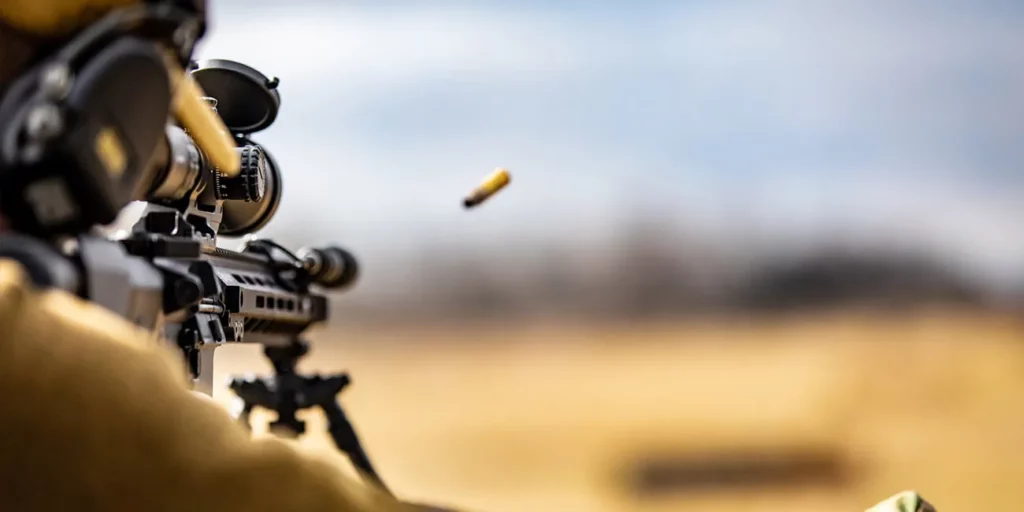
If you’re thinking about upgrading your AR15—or if you think you might need to start from square one—we have a wide selection of products that will meet your needs. As always, if you have questions about subjects or items covered in this blog, feel free to reach out to us. Just send us a direct message on Facebook, Instagram, or Twitter, and we’ll help however we can!



